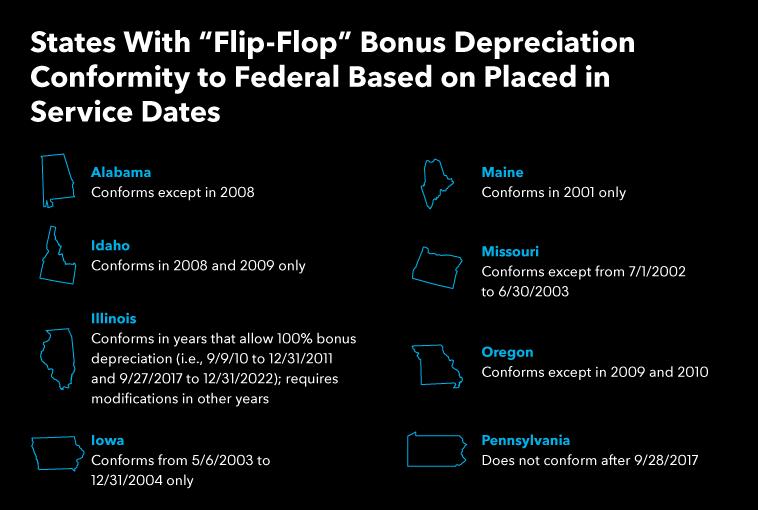Depreciation Challenges for “Flip-Flop” Bonus Conformity States
Keeping up with tax law at the state level has always been challenging for corporate taxpayers, especially because states do not consistently conform to the Internal Revenue Code (IRC). The passage of the 2017 Tax Cuts and Jobs Act (TCJA) added to this challenge by creating significant uncertainty regarding the states’ response to “full expensing” (i.e., the new 100% bonus depreciation rate).
States that have gone back and forth between conforming and not conforming with federal bonus depreciation (“flip-flop” states) present added complexity for taxpayers because of differing treatment across years. For these states, calculating federal to state depreciation modifications and adjusted basis differences for gain or loss determination becomes even more difficult.
Calculating modifications for state compliance reporting
To compute state taxable income, most states use federal taxable income as a starting point. However, each state imposes certain addition or subtraction modifications to arrive at state taxable income. For states that do not conform to bonus depreciation, and therefore require related addition and subtraction modifications, compliance can be particularly difficult. Keeping track of these modifications over time is critical because the additions and subtractions change each year and ultimately sum to a net modification to state taxable income.
In addition, many states require corporate taxpayers to file additional state tax forms, which in turn require detailed supporting documentation that can be burdensome. Some states require the reported modifications to be broken out by type of depreciation (e.g., Section 179, bonus depreciation, regular MACRS), whereas others require a single modification amount to reconcile the difference between the total federal and state depreciation. While some states have their own unique depreciation schedules, others require taxpayers to complete a separate Form 4562 for state depreciation purposes as if bonus depreciation had not been claimed.
[Learn how you can manage state bonus depreciation with ease using Bloomberg Tax Fixed Assets.]
For example, Pennsylvania requires corporations to compute depreciation for property placed in service after Sept. 27, 2017, under the regular Modified Accelerated Cost Recovery System (MACRS) rules, without regard to bonus depreciation. For property placed in service prior to Sept. 28, 2017, Pennsylvania allowed federal bonus depreciation but required an addback of bonus and a subsequent 3/7 formula.
Let’s look at an example with the following facts:
Asset #1
- Cost: $300,000
- Recovery period: 3 years
- Depreciation method: Straight-line
- Placed-in-service date: January 1, 2017
- Federal bonus depreciation: 50% of 300,000 = 150,000
- Federal regular depreciation: 150,000/3 = 50,000
- State regular depreciation: 50,000 x 3/7 = 21,429 [in 2019, asset is fully depreciated for federal purposes, so PA allows deduction of remainder (150,000 – 21, 429 – 21,429 = 107,142)]
Asset # 2
- Cost: $300,000
- Recovery period: 5 years
- Depreciation method: Straight-line
- Placed-in-service date: January 1, 2018
- Federal bonus depreciation: 100% of 300,000
- Federal regular depreciation: 0
- State regular depreciation: 300,000/5 = 60,0000
Addition and Subtraction Modifications in Subsequent Tax Years
[Learn more about Pennsylvania’s complicated history with bonus depreciation.]
Taxpayers often keep track of these modifications in Excel spreadsheets. The maintenance of these workpapers is generally a manual effort and can be extremely time consuming and cumbersome, especially when the taxpayer files in many states. Maintaining separate depreciation books for each state with the correct bonus depreciation configurations by period may be one way to help tackle this challenge.
This approach enables taxpayers to compare the detailed depreciation differences from the federal and state books without manually tracking and accumulating modifications from year to year. However, maintaining separate books in Excel can still be a very time-consuming effort. Investing in a software that automates the state depreciation calculations using built-in tax laws can significantly reduce risk and time spent on manually updating Excel calculations across the many states where this is an issue.
Tracking adjusted basis for gain/loss determination
In general, the adjusted basis of an asset is its cost reduced by the depreciation allowed or allowable over the life of the asset. For purposes of determining regular depreciation under MACRS, an asset’s adjusted basis is first reduced by the bonus depreciation amount.
Consequently, a state not conforming to (i.e., disallowing) bonus depreciation causes federal and state adjusted basis differences. Maintaining accurate records is especially important because, upon disposal, any accumulated basis differences will result in a difference between the gain or loss reported at the state and federal levels.
Instead of tracking modifications to state depreciation over time to arrive at state adjusted basis, maintaining a separate state depreciation book can reduce reconciliation times and help to ensure accuracy.
Let’s look at an example with the following facts:
- Cost: $1,000,000
- Recovery period: 7 years
- Depreciation method: 200% declining balance
- Placed-in-service date: January 1, 2020
- Disposal date: December 31, 2021
- Disposal proceeds: $800,000
- The state in question does not conform to bonus depreciation
Computation of Adjusted Basis at 12/31/2021
Gain Computation Differences for Tax Year 2021
States with “Flip-Flop” Bonus Conformity
The following is a list of states that have historically flip flopped conformity. Taxpayers should determine whether there are any depreciation impacts in open tax years and continue to monitor these states due to their complexity.

[For the latest updates and information on cross-border tax issues, visit our international tax resource page.]